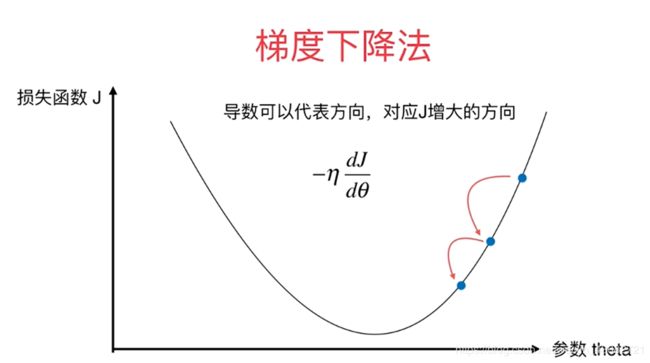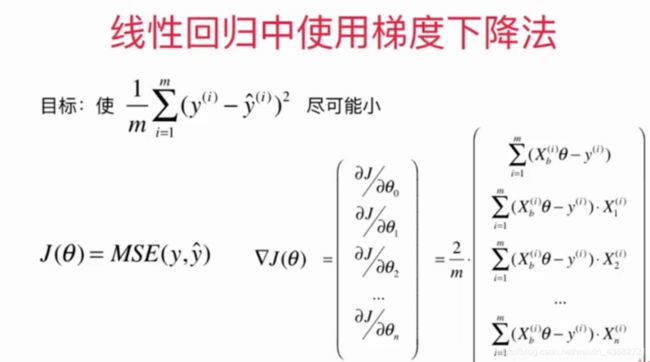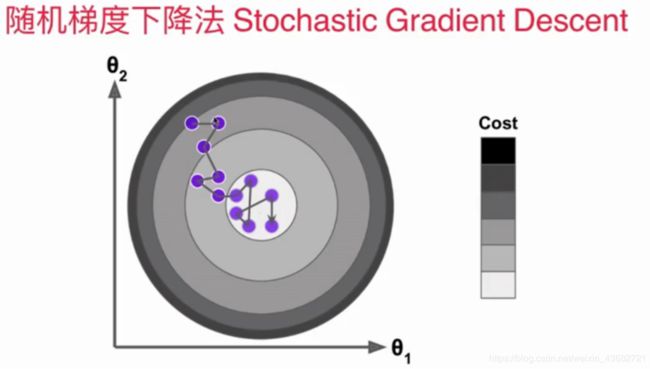梯度下降法 及其Python实现
什么是梯度下降法
梯度下降 Gradient Descent:本身不是一个机器学习的算法,而是一种基于搜索的最优化方法。
作用:最小化一个损失函数。
梯度上升法:最大化一个效用函数。

- η称为学习率(learning rate)
- η的取值影响获得最优解的速度:如当η过小,需要经过非常多次的迭代
- η取值不合适,甚至得不到最优解:如当η过大,可能不能到达使目标更小的点
- η是梯度下降法的一个超参数
初始点:
而线性回归法的损失函数具有唯一最优解。
线性回归中的梯度下降法
实现线性回归中的梯度下降法
将下面的方法写在LinearRegression.py中,作为线性回归的一种训练方式:
def fit_gd(self,X_train,y_train,eta = 0.01, n_iters = 1e4):
'''根据训练数据集X_train,y_train,使用梯度下降法训练线性回归模型'''
assert X_train.shape[0] == y_train.shape[0] , 'the size of X_train must equal to the size of y_train'
def J(theta,X_b,y):
'''计算损失函数'''
try:
return np.sum((y - X_b.dot(theta))**2) / len(y)
except:
return float('inf')
def dJ(theta,X_b,y):
'''计算损失函数在每一个特征上的导数,即为梯度'''
res = np.empty(len(theta))
res[0] = np.sum(X_b.dot(theta) - y)
for i in range(1,len(theta)):
res[i] = (X_b.dot(theta) - y).dot(X_b[:,i])
return res * 2 / len(X_b)
def gradient_descent(X_b,y,initial_theta,eta,n_iters = 1e4,epsilon = 1e-8):
'''计算随着梯度下降,最终得到的theta'''
theta = initial_theta
cur_iter = 0
while cur_iter < n_iters:
gradient = dJ(theta,X_b,y)
last_theta = theta
theta = theta - eta * gradient
if(abs(J(theta,X_b,y) - J(last_theta,X_b,y)) < epsilon):
break
cur_iter += 1
return theta
X_b = np.hstack([np.ones((len(X_train),1)),X_train])
initial_theta = np.zeros(X_b.shape[1])
self._theta = gradient_descent(X_b,y_train,initial_theta,eta,n_iters)
self.interception_ = self._theta[0]
self.coef_ = self._theta[1:]
return self
使用方式为:
#数据
x2 = 2 * np.random.random(size = 100)
y2 = x2 * 3. + 4. + np.random.normal(size = 100)
x2 = x2.reshape(-1,1)
reg2 = LinearRegression()
reg2.fit_gd(x2,y2)
print(reg2.coef_)
print(reg2.interception_)
梯度下降法的向量化和数据标准化
梯度下降法的向量化
def dJ(theta,X_b,y):
# res = np.empty(len(theta))
# res[0] = np.sum(X_b.dot(theta) - y)
# for i in range(1,len(theta)):
# res[i] = (X_b.dot(theta) - y).dot(X_b[:,i])
# return res * 2 / len(X_b)
return X_b.T.dot(X_b.dot(theta) - y) * 2 / len(y)
数据归一化
如果数据不属于同一个量级,在梯度变化的过程中,同一步长对多个特征的影响不同,这导致目标函数可能不能收敛。因此需要进行数据的归一化。
from sklearn.preprocessing import StandardScaler
standardScaler = StandardScaler()
standardScaler.fit(X_train)
X_train_standard = standardScaler.transform(X_train)
正规方程法与梯度下降法
正规化方程不需要进行数据归一化,而梯度下降法需要进行数据归一化。
当数据的特征数大时,梯度下降法相对于正规方程法而言,更为省时。
随机梯度下降法
def fit_sgd(self,X_train,y_train,n_iters = 5,t0 = 5,t1 = 50):
'''根据训练数据集使用梯度下降法训练线性回归模型'''
assert X_train.shape[0] == y_train.shape[0],'the size of X_train must equal to the size of y_train'
assert n_iters >= 1
def dJ_sgd(theta,X_b_i,y_i):
return X_b_i * (X_b_i.dot(theta) - y_i)*2.
def sgd(X_b ,y ,initial_theta,n_tiers,t0 = 5,t1 = 50):
def learning_rate(t):
return t0 /(t +t1)
theta = initial_theta
m = len(X_b)
for cur_iter in range(n_iters):
indexes = np.random.permutation(m)
X_b_new = X_b[indexes]
y_new = y[indexes]
for i in range(m):
gradient = dJ_sgd(theta,X_b_new[i],y_new[i])
theta = theta - learning_rate(cur_iter * m + i) * gradient
return theta
X_b = np.hstack([np.ones((len(X_train),1)),X_train])
initial_theta = np.random.randn(X_b.shape[1])
self._theta = sgd(X_b,y_train,initial_theta,n_iters,t0,t1)
self.interception_ = self._theta[0]
self.coef_ = self._theta[1:]
return self
测试:
reg3 = LinearRegression()
reg3.fit_sgd(X3,y3, n_iters = 2)
print(reg3.coef_)
print(reg3.interception_)
scikit-learn中的随机梯度下降法
scikit-learn中随机梯度下降法的使用:
from sklearn.linear_model import SGDRegressor
sgd_reg = SGDRegressor(n_iter = 100)
sgd_reg.fit(X_train_standard,y_train)
sgd_reg.score(X_test_standard,y_test)




